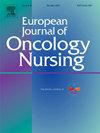Time-specific exploration of core symptoms in breast cancer: A cross-lagged panel network analysis
IF 2.7
3区 医学
Q1 NURSING
引用次数: 0
Abstract
Purpose
To construct symptom networks at five time points within six months post-surgery, thereby monitoring dynamic trends of core symptoms in breast cancer patients.
Methods
The current study evaluated the prevalence and severity of symptoms during 6 months post-surgery period, using the Anderson Symptom Assessment Scale. The Cross-lagged panel network (CLPN) model was employed to identify core symptoms at each stage and to examine the dynamic trend of core symptoms in breast cancer patients. The study was reported following the STROBE checklist.
Results
Totally, 225 participants were included. During T1→T2, sadness presented the highest out-EI. During T2→T3, distress had the largest value of out-EI. During T3→T4 and T4→T5, shortness of breath and drowsiness were both reported with the largest out-EI.
Conclusions
The core symptoms of breast cancer patients exhibited a dynamic trend, shifting from emotional symptoms in the T1-T3 stage to physical symptoms, such as shortness of breath and drowsiness in the T3-T5 stage. Attention should be paid to developing targeted intervention programs for these core symptoms, with the goal of advancing precision symptom management and enhancing patient health outcomes across the entire course of treatment.
乳腺癌核心症状的时间特异性探索:交叉滞后面板网络分析
目的构建乳腺癌术后6个月内5个时间点的症状网络,监测乳腺癌患者核心症状的动态变化趋势。方法本研究采用安德森症状评估量表评估术后6个月症状的发生率和严重程度。采用交叉滞后面板网络(cross -lag panel network, CLPN)模型识别各阶段的核心症状,观察乳腺癌患者核心症状的动态变化趋势。该研究按照STROBE检查表进行报告。结果共纳入225名受试者。在T1→T2阶段,悲伤情绪的外情商最高。在T2→T3阶段,窘迫的out-EI值最大。T3→T4和T4→T5时均出现呼吸短促、嗜睡,且out-EI最大。结论乳腺癌患者的核心症状呈现动态变化趋势,由T1-T3期的情绪症状向T3-T5期的呼吸短促、嗜睡等躯体症状转变。应注意针对这些核心症状制定有针对性的干预方案,以推进精确的症状管理,并在整个治疗过程中提高患者的健康结果。
本文章由计算机程序翻译,如有差异,请以英文原文为准。
求助全文
约1分钟内获得全文
求助全文
来源期刊
CiteScore
4.40
自引率
3.60%
发文量
109
审稿时长
57 days
期刊介绍:
The European Journal of Oncology Nursing is an international journal which publishes research of direct relevance to patient care, nurse education, management and policy development. EJON is proud to be the official journal of the European Oncology Nursing Society.
The journal publishes the following types of papers:
• Original research articles
• Review articles

 求助内容:
求助内容: 应助结果提醒方式:
应助结果提醒方式:


